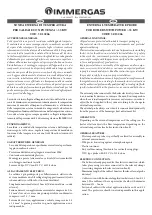
Operation and installation manual 2015.12.07
14
In the evening, before burning in the boiler during the night, the grate should be cleaned thoroughly. In the
morning, after night burning, remove caked coal with a hook to clear the air supply. Put some fuel onto the embers
and do not remove ash and caked fuel from the grate until the fuel is burning. Then add fuel until the combustion
chamber is full. Each time you check the amount of fuel
in the combustion chamber and each time before stoking
the fire, switch off the fan on the regulator (preferably by switching off the regulator) and delay opening the
loading door until the fan stops; the door is leak-tight and you should first loosen it slightly, wait until pressure in
the combustion chamber equalises and only then can you open the door fully. This will prevent hot flue gas from
being blown out into the boiler room. The lower door of the furnace, the door of the lower combustion chamber and
the loading door must be tightly closed during the boiler operation.
NOTE: When opening any of the boiler's doors, stand in such a way as to prevent any hot gas from the boiler from
causing harm to you or to anyone standing nearby.
Adding more fuel – switch off the fan first (preferably by switching off the regulator).
After the fan is
switched off and stopped, open the lower door of the boiler. Open the upper door of the boiler after a while,
unsealing it first, and put in a layer of fuel. After the upper and lower door is closed, switch on the fan by pressing
the button (as above). The boiler is now in normal operation mode. Do not add too much fuel as it may cause the
boiler to overheat quickly and it negatively affects the boiler's parameters as well as the parameters of emission of
hazardous substances in flue gas.
Boiler maintanance
Remove ash to non-flammable, closed containers with increased resistance to corrosion (for example zinc-
plated). The boiler can be cleaned only after it has been extinguished and cooled down!!! Cleaning the walls of
the upper combustion chamber can be easily done through the open upper door. Cleaning the smoke conduits is
done through the inspection hatch under the casing (the same as cleaning in automatic mode). The boiler can be
cleaned with the cleaning tools supplied with it. A boiler that has been soiled with tarry substances should be
cleaned in two steps. First, tarry deposits should be burnt out with suitable agents (for example Sadpal), and then
the heat exchange areas should be cleaned with a brush. Cleaning semi-liquid tarry deposits results in damage to
the brush and is ineffective, resulting only in spreading the tar over the boiler surface.
After the boiler surface and smoke conduits have been cleaned, close the inspection hatch tightly.
NOTE: Avoid accumulation of tarry deposits and soot on the heat exchanger areas and in smoke conduits. This
reduces the boiler’s efficiency and poses a serious hazard of soot and tar ignition in the chimney duct, which
usually results in damaging the chimney and even the building walls and in fire.
Take care to make the boiler leak-tight (combustion chamber door, ash pan door, mixer cleaning hole, fuel
bin cover, etc.) in order to avoid flue gas being expelled from the boiler into the boiler room.
If the boiler is not in use for more than 2 days (for example, after the heating season), it must be cleaned and
the fuel bin and the fuel feeding system emptied of fuel. Leave the boiler with the doors and inspection hatch
covers open to enable its ventilation and to avoid moisture condensation on the steel surfaces of the boiler.

































